14K Gold: The Complete Guide
Understand gold purity and jewelry styles and whether 14k is the best fit for you
Understand gold purity and jewelry styles and whether 14k is the best fit for you
Represented by the chemical symbol Au and atomic number 79, gold is a naturally occurring element. As the most malleable of all metals, gold makes for an ideal material when creating fine jewelry. 14K gold is a mixture consisting primarily of gold, blended with durable metals such as zinc, nickel and copper along with a rhodium plating. Gold by itself is relatively soft, so the alloy metals strengthen the composition. 14 Karat specifically refers to the metal mix that is 58.3% gold.
Due to its high durability and relatively low cost, 14 Karat gold is used for engagement rings, eternity bands, pendants, earrings and other fine jewelry pieces. Its is estimated that 90% of engagement and wedding rings sold are made from 14K gold.
Gold jewelry can be identified by a “hallmark stamp”. In The United States gold will be stamped with it’s karatage such as 14K or 14Kt.
Are you looking to sell your gold? This article is geared towards helping people looking to purchase jewelry. If you are looking to sell your gold, feel free to hop on over to our Selling Your Jewelry page. If you are looking to sell your diamond engagement ring, we have a specific article for Selling Your Diamond Ring
Gold pricing calculator
Is 14K gold real?
How to identify 14K gold?
14K gold purity
What is 14K white gold?
What is 14K yellow gold?
What is 14K rose gold?
How much does a 14K diamond ring cost?
When to buy a 14K gold diamond ring?
Popular 14K gold jewelry
FAQs
Why you should trust us
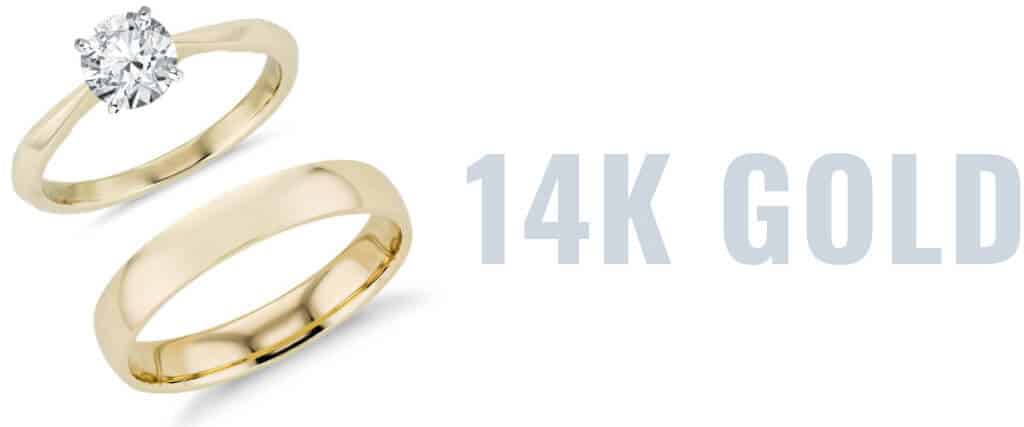
Despite being the more affordable option, 14K gold looks every bit as classy as any of the other metals. One of our readers put this $20,000 diamond into a 14K white gold setting from James Allen and it looked absolutely stunning.
14K gold is an excellent choice for an engagement ring or any other piece of fine jewelry. As a beautiful and durable metal, 14K gold is also reasonably priced. The color of gold you decide on should primarily be based on personal preference, skin tone and current fashion. Consider a yellow gold setting like this pave engagement ring from James Allen, this solitaire rose gold setting from James Allen or this white gold halo setting like this from James Allen. For assistance in selecting a stunning setting or diamond, be sure to contact our experts.
This email will go to our contact at Abe Mor who has helped thousands of our readers sell their gold and diamond jewelry. They consistently offer the highest prices for our readers' jewelry. Please include the weights and details of the jewelry. Images are helpful as well.
$0
ValueThis is the current wholesale price of gold. When selling gold you receive a percentage of the price. We recommend asking Abe Mor for a quote as they have consistently offered the highest percentage to our readers.
Get an OfferYes. 14K gold is definitely real gold. Contrary to popular belief, almost no jewelry (and certainly no engagement rings, earrings or other pieces that are worn frequently) are made using 100% pure, 24K gold.
The reason for this is simple: pure, 24K gold is extremely soft, making it easy to scratch, warp and bend. We’ve explained this in greater detail below, along with why 14K gold is usually the best type of gold for an engagement ring.
If you’re shopping for an engagement ring or other gold jewelry online or in a store, identifying a piece that’s made using 14K gold is easy — just look at the item’s description or tag.
According to Hobart M. King, PHD in geology, the overwhelming majority of gold is used for jewelry. Roughly 10% is used by governments for coinage and reserves. 12% is used for consumer electronics.
Outside of a store environment, there are several ways to identify a ring or other piece of jewelry as being made from 14K gold. The easiest way is to look for a stamp that lists the piece’s metal mixture.
The stamp applied to a piece of gold jewelry is called a “hallmark.” Hallmark laws date back to the 13th century and were used historically to protect gold buyers before wide-scale gold purity testing became available.
Gold stamps can vary from country to country. In the US, gold jewelry doesn’t need to have a stamp indicating its purity in order to be legally sold — instead, the item’s karatage needs to be marked somewhere close to the piece, such as its packaging.
However, most high quality 14K gold rings and other items are still stamped for purity using a variety of different hallmarks.
Below, we’ve listed some of the most common 14K gold stamps, along with additional information on what each stamp means:
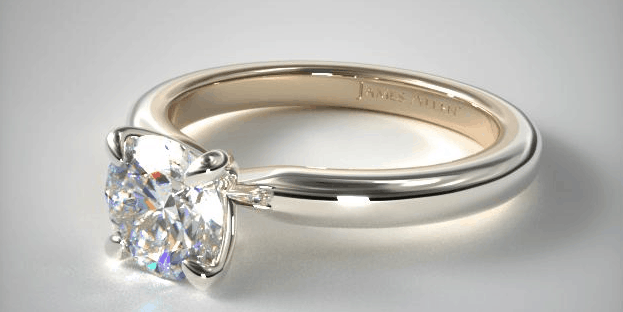
If you’ve been doing the math in your head for that last example, you might have noticed that it doesn’t make a lot of sense. After all, if 14K gold is 58.3% pure gold, shouldn’t it be use a “583” stamp instead of a “585” one?
The reason for the 585 stamp is that many manufacturers produce their 14K gold to be slightly purer than the 14 out of 24 parts standard. This is a popular European practice that’s followed by many producers of gold jewelry, thus the “585” stamp.
You might also see a “583” stamp used to mark some gold jewelry. Just like the “585” stamp, a “583” stamp means that a ring, watch or other piece of jewelry is made using 14K gold.
The price of gold jewelry stamped 585 or 583 is identical to that of gold stamped with 14K or a similar marking — there’s no difference in price, value or purity.
It’s important to know that there are other common gold stamps that include the term “14K” which may not indicate a piece is made from 14K gold. These include the following:
As we mentioned above, not all countries require manufacturers of gold jewelry to stamp their products. As such, if a piece of gold jewelry isn’t stamped, this doesn’t necessarily mean that it isn’t 14K gold (or 10K, 18K or any other common gold purity level).
It’s also important to be aware that some gold jewelry can be stamped using a dishonest purity hallmark. For example, some unscrupulous jewelry manufacturers might stamp a piece with a “14K” hallmark, even if the piece is only gold plated.
This is only common in countries without strict hallmarking laws, or in less reputable markets for jewelry. In general, you’ll only need to worry about this if you buy gold jewelry second hand, or if you shop in an unregulated environment (for example, a yard sale or street market).
Because pure gold is too soft to be worn every day, it is essential to create a metal mixture when using gold for jewelry. 14K gold is an alloy composition made of gold and durable metals like zinc, nickel, silver and copper along with a rhodium plating. This sturdy blend is resistant to corrosion, rust and tarnish.
Karatage, which is expressed in 24ths and designated by a number followed by “k,” denotes the purity level of the gold. 24K gold, for example, is 100% gold. 18K gold is 75% gold and 14K gold is 58.3% gold.
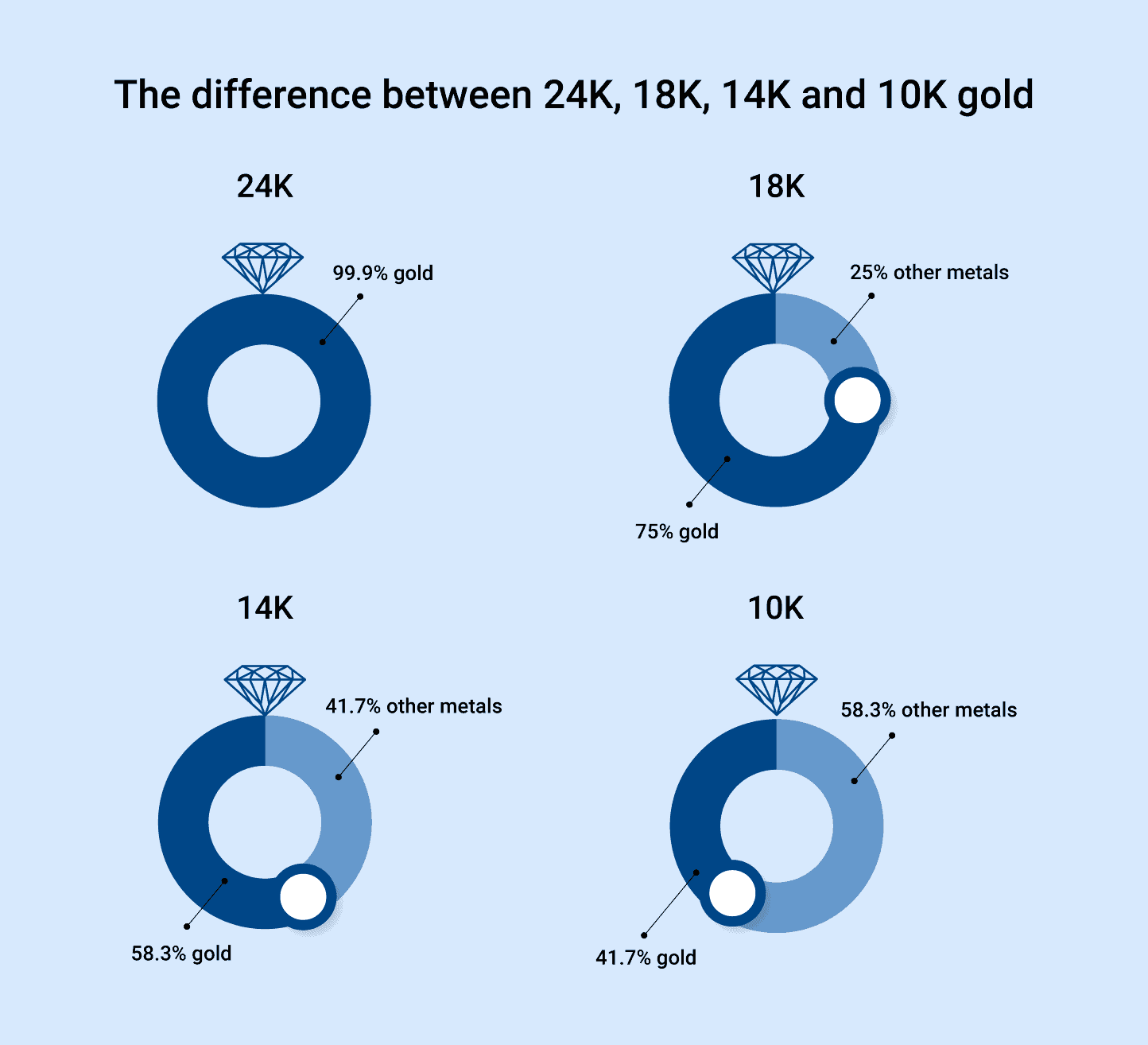
Although a higher karat indicates a purer gold content, it also means a less durable metal. For this reason, 14K or 18K golds are usually used for engagement and wedding rings.
When selecting a 14K gold setting, you’ll notice three options: white gold, rose gold and yellow gold. While similar, each color differs in composition. The type of metal alloys used and percentage of each metal indicates what color the gold is.
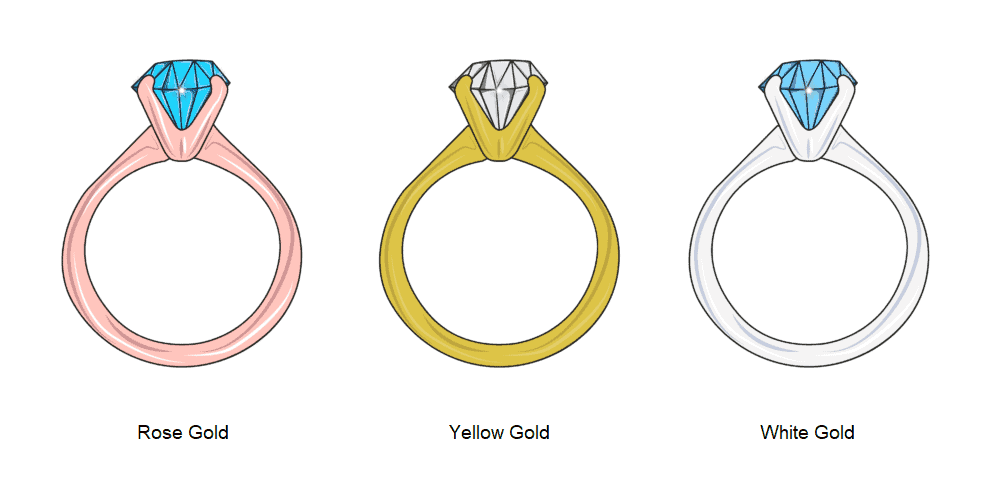
Selecting the color of gold for your engagement ring or jewelry should be based primarily on personal preference, although composition and price may play a small role in your decision. For example, we recommended a white gold setting to one of our readers. They ended up going with this rose gold pave setting and a two carat diamond from James Allen and, as you can see, they made an excellent choice.
White gold is a mixture of pure gold and white metals like silver, nickel and palladium, usually with a rhodium coating. 14K white gold is a good choice of metal that looks particularly stylish on people with rosy or fair skin.
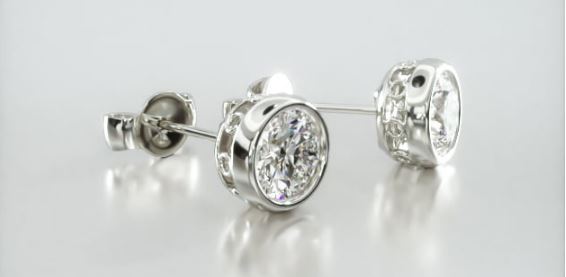
Advantages of 14K white gold:
Disadvantages of 14K white gold:
The different colors of 14K gold (white, yellow and rose) don’t differ significantly in price. Despite looking similar to more expensive metals such as platinum, 14K white gold is quite an affordable metal that generally offers very good value for money.
We’ve explained the price of 14K white gold in more detail further down the page in our section on 14K gold pricing. In general, you shouldn’t need to pay any more for an engagement ring in 14K white gold than in any other gold color of equivalent karatage.
Yellow gold is formed of pure gold and alloy metals like zinc and copper.
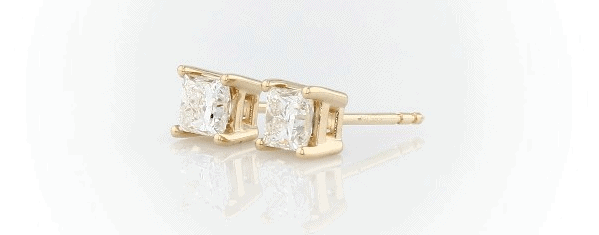
Advantages of 14K yellow gold:
Disadvantages of 14K yellow gold:
Rose gold refers to and encompasses the whole family of red, rose and pink shades of gold. With these colors, pure gold is alloyed with copper to produce the rose color. The more copper present in the mixture, the redder the gold appears. Similar to white gold, “pure rose gold” doesn’t exist—it is always an alloy. Jenni Farley wears her engagement ring in rose gold proudly and we all love it!
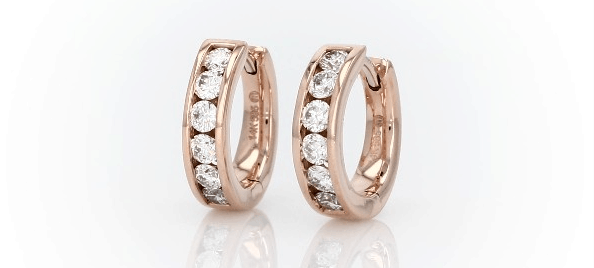
Advantages of 14K rose gold:
Disadvantages of 14K rose gold:
In general, the price of a 14K engagement ring setting can range from a few hundred dollars to several thousand dollars, depending on the type of setting you choose. Solitaire settings in 14K gold tend to be the most affordable, while more ornate settings can be significantly more costly.
Not sure how much you should set aside for a 14K gold engagement ring? 14K gold is the most popular choice of engagement ring metal, largely due to the fact that it offers a similar look and superior durability to 18K gold at a lower price.
We’ve explained this in more detail below, with several examples of 14K gold diamond rings to give you a full idea of how much you should spend on a setting.
The price of a diamond ring can vary tremendously based on two factors. The first is the type of metal that you choose (for example, 14K gold) for the setting. The second is the size and quality of the diamond you choose to set in the ring.
We’ve covered diamond prices in our price article, so let’s look at the amount you’ll spend for the setting.
When looking at the price of 14K gold, it’s often helpful to compare it to other fine metal types: platinum and 18K gold.
Generally speaking, 14K gold will be less expensive than both of these options, as it contains a lower percentage of gold relative to its other alloy metals. It will also be considerably cheaper than a platinum setting.
For example, the platinum setting for this solitaire ring from Blue Nile costs $990. A similar 18K white gold setting, like this one from Blue Nile, costs $740, while this similar 14K gold setting from Blue Nile only costs $410. 14K gold offers durability and beauty while being the most affordable of fine jewelry metals.
The price of 14K gold doesn’t change much when it comes to color. For instance, this white gold solitaire setting from Brian Gavin costs $440, a similar ring in yellow gold from Blue Nile costs $410 and a similar setting in rose gold from James Allen is priced at $420.
Overall, you should expect to spend about 20-35% less for a 14K gold solitaire engagement ring setting than you would for a similar setting in 18K gold.
For a pavé, halo or side stone ring, there’s generally a smaller difference in pricing between 14K and 18K gold. This is because the gold used to make the ring accounts for a smaller percentage of its price, with the side, halo or pavé diamonds accounting for more.
For example, this 14K white gold petite pavé engagement ring from James Allen costs $960. The same ring made from 18K white gold from James Allen costs $1,150, making the 14K ring barely 16% cheaper.
For settings with even more diamonds, the price difference between 14K and 18K gold can get even smaller. For example, this white gold halo engagement ring, which features almost 1 carat of small diamonds, costs $5,100 in 14K gold and $5,470 in 18K gold — a mere 7% difference.
In short, a 14K gold diamond ring is about 20-35% cheaper than the equivalent ring made from 18K gold. However, the value advantage offered by 14K gold becomes smaller when diamonds and other features begin to affect the cost of the setting.
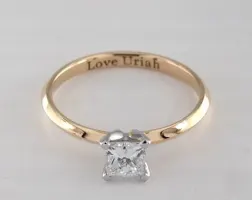
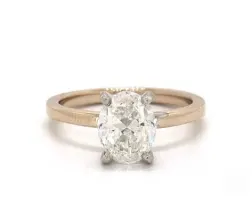
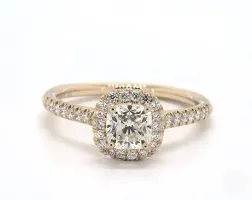
The metal you choose for your jewelry should depend mostly on appearance, but also on longevity and cost. 14K gold is affordable compared to platinum and 18K gold options, making it an excellent choice for many budgets. 14K gold is ideal for engagement rings, but also pendants, bracelets, earrings, promise rings, and other fine jewelry pieces.
When it comes to determining the color of gold for an engagement ring, you’ll want to make sure the diamond looks white in relation to its setting. For instance, this J colored round cut diamond from Blue Nile, which sometimes has a slight tint, looks white in relation to a 14K yellow gold setting. Yellow gold is often a great match for a stone with a lower color grade. This G color-graded diamond from James Allen pairs well with a white gold setting, though would certainly still look colorless in yellow or rose gold as well.
No matter the color you choose, 14K gold is an ideal choice for jewelry that will be worn daily and carries special meaning.
14K gold remains the most popular metal for engagement rings, at nearly 90% of all rings sold. It is durable, not easily tarnished and beautiful in any color.
14K gold engagement ring inspiration
14K gold chain inspiration
14K earrings inspiration
14K bracelets inspiration
To create the perfect ring or another piece of fine jewelry, reach out to our experts who can help you find the highest quality diamonds and 14K gold—all while staying within budget.
Yes, 14K gold is generally fine to wear in the shower. Water does not affect gold, and 14K gold is pure enough that it should not wear down or fade by wearing it in the shower or bath.
14K gold lasts a very long time before tarnishing. 14K gold is made up of 58.3% pure gold. Gold itself does not tarnish, but other metals that make up sub-24K golds may do. A little care and polishing should be enough to ensure that your 14K gold jewelry lasts a lifetime without fading.
14K solid gold is significantly better and more valuable than gold-plated jewelry. Though other metals are mixed in, 14K gold jewelry is essentially gold throughout, making it sturdy, durable and aesthetically beautiful. Gold-plated jewelry, however, has only a thin layer of gold on top of other metals. This layer may not last long, and is far less valuable than solid gold jewelry.
14K gold is great for everyday wear. The additional metals contained help make it more durable, more scratch-resistant than 18K gold (or higher), meaning it stands up well to constant use.
Assuming you care for it well, 14K gold should last forever. Gold lasts a long time, and is unlikely to tarnish, corrode or degrade, even with a lifetime of everyday wear.
Gold jewelry should have a stamp or “hallmark” showing its metal mixture. Depending on the area of the world, this may legally need to be marked on the gold itself, or (in the US), somewhere close by, like the item’s package. The gold may be stamped with a 14K or 14Kt symbol, indicating “14 karat”, or a “583 or 585”, indicating 583/585 grams of gold per thousand.
14K white gold jewelry can be beautiful, valuable, and good value for money. It’s generally a good choice for its appearance, but not as an investment. Gold jewelry in general is likely to return only around 50% of its purchase price when resold. So if you’re buying gold as an investment, buy gold bars or bullion, not jewelry.
If you’re interested in selling your jewelry, check out our selling gold article.




Before you buy a diamond, get personal buying advice from industry veterans. We'll help you get the best diamond for the money.
DISCLAIMER: We don't use your email for marketing. Period.
A diamonds’ price is determined primarily by the 4 Cs of the diamond. On the wholesale level, diamond prices are first based on a diamond shape and
Buying an engagement ring is often one of the first major purchases in a person's life. The process can be fraught with tension as there are so m
A wide range of 1 carat diamonds exist both in online markets and local diamond jewelry stores. Not only are there significant differences in beauty
Please enter your email address to receive your 25% off coupon code:
Here is your coupon code: GFDSF3GF